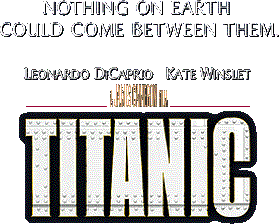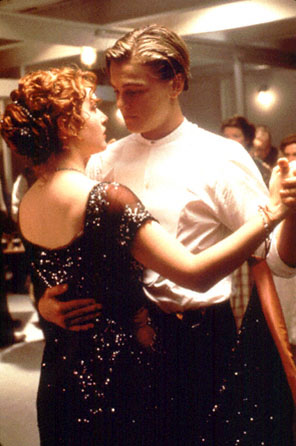 This site has been enhanced with music
This site has been enhanced with music  You may turn it off by using the controls on the recorder above.
You may turn it off by using the controls on the recorder above.

 "Nothing on earth could come between them."
"Nothing on earth could come between them."

For Your Information:
* Captain of the Titanic: Edward J. Smith (who went down with the ship).
* Time when the Titanic struck the iceberg: 11:40 p.m., April 14, 1912.
* Number of people aboard the Titanic: 2,228.
* Number who died in the disaster: 1,523.
* Number of people who died building the Titanic: 2.
* Time it took the Titanic to sink: 2 hours and 40 minutes.
* Approximate location of the Titanic wreck site: Lat. 41 degrees N, 49 degrees W.
* Number of miles beneath the ocean's surface that the Titanic wreckage rests: 2.5.
* Overall length of the Titanic: 882 feet, 9 inches.
* Time it took to build: 2 years and 2 months.
* Date it actually sailed: April 10.
The RMS Titanic, the 20th century's most famous sunken treasure, resurfaces this weekend on movie screens across the country, in what is perhaps the most eagerly anticipated (and incessantly hyped) Hollywood film of the decade.
Titanic, director James Cameron's $200 million, three hour-long version of the ship's disastrous maiden voyage, arrives in theaters as the most expensive movie ever filmed, an epic both schlocky and grand. Cameron is well aware of the Titanic's mythic stature in American culture, and he is determined to exploit it; everything in Titanic -- from the kitschy, almost "Love Boat"-esque tableaux of wind-swept, shipboard romance, to the truly remarkable use of state-of-the-art, computer generated special effects -- is written large, conveying a sense of the epoch-defining enormity of the catastrophe which claimed 1,503 lives in the icy North Atlantic on April 14, 1912.
 By accident or design, the release of Cameron's Titanic is perfectly timed: it arrives in theaters at a moment when American popular culture is throes of renewed fascination with this seminal 20th century event. The year that ended with the appearance of Cameron's movie, began with the debut of Broadway's version of Titanic, which went on to win the Tony Award for best musical. RMS Titanic, Inc. -- the New York-based company that owns salvage rights to the Titanic -- have spent the last several years attempting to raise portions of the sunken ship, staging museum exhibitions of recovered Titanicania, turning the raiding of the ship's "watery grave" into big business. Titanic merchandise -- countless books, CD-ROMs, replicas of the ship's tea service, even "authentic Titanic coal," pulled from the ship's wreckage and hocked on the Internet -- is flooding the market and selling briskly.
By accident or design, the release of Cameron's Titanic is perfectly timed: it arrives in theaters at a moment when American popular culture is throes of renewed fascination with this seminal 20th century event. The year that ended with the appearance of Cameron's movie, began with the debut of Broadway's version of Titanic, which went on to win the Tony Award for best musical. RMS Titanic, Inc. -- the New York-based company that owns salvage rights to the Titanic -- have spent the last several years attempting to raise portions of the sunken ship, staging museum exhibitions of recovered Titanicania, turning the raiding of the ship's "watery grave" into big business. Titanic merchandise -- countless books, CD-ROMs, replicas of the ship's tea service, even "authentic Titanic coal," pulled from the ship's wreckage and hocked on the Internet -- is flooding the market and selling briskly.
What explains this Titanic renaissance? Why does this icon continue to exert so powerful a hold on the public imagination, decade after decade?

Almost immediately after the Titanic sunk in 1912, a battle was joined to define the meaning of the tragedy. Suffragists and their opponents, radicals and capitalists, critics of modern life, xenophobe "nativists" and proponents of immigration and racial and ethnic tolerance -- all found lessons in the story of the Titanic. Over the years, the Titanic has continued to be appropriated: in the Cold War, as a symbol of ambivalence about technology run amok; when the Titanic's wreck was discovered in the 1980s, as a symbol of American triumphalism.

A combination of nostalgia and desire seems to be behind much of the current interest in the Titanic: nostalgia for the jaunty spirit of a "simpler" age, desire for the elegance and opulence of the great ship itself. Americans love the trappings of wealth, and the Titanic -- along with the Guggenheims, Strauses and Astors she carried on her maiden voyage -- had these trappings in abundance. The RMS Titanic, Inc.-sponsored "Titanic: the Exhibition," running through May 15, 1998 at the Florida International Museum in St. Petersburg, contains over 300 objects dredged from the wreckage field surrounding the ship. The exhibition has been drawing overflow crowds to view objects like an ornately decorated first class service plate, a bronze cherub which may have adorned the first-class grand staircase, diamond and sapphire rings and hundreds of other relics of an irresistibly romantic and remote high life. Even Cameron's Titanic, with its steerage-class hero and its cautionary message about class snobbery and hubris, cannot help but fetishize the gleaming, glamorous ship.
The most arresting pictures in the movie, however, are not the rather stylized scenes aboard Cameron's reconstructed Titanic but the otherworldly images of the Titanic shipwreck that begin the film. These scenes are mysterious and jarring: the Titanic has been imagined and depicted so variously in the past 85 years, it is oddly disconcerting to see the thing itself, a spooky-miniature Atlantis, encrusted with barnacles and encircled by fish.
"When we shot the wreck," Cameron has said, "it was a religious experience. There's something about the wreck of the Titanic that is profoundly spiritual."
Cameron and Paramount pictures have staked $200 million on the idea that audiences will make this same pilgrimage to one of the shrines of America's strange, magisterial, gaudy popular culture. Don't bet against them.
-- Jody Rosen
A deliriously ambitious movie, directed by Hollywood's most obsessive perfectionist, brings two studios to the brink of war.
- Anne Thompson
 Go To Our Home
Go To Our Home
 tgeorge@sonet.net
tgeorge@sonet.net






